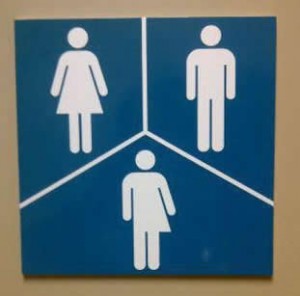“Making Bathrooms More ‘Accomodating'” by Emily Bazelzon examines the issues associated with transgender people and bathrooms. Bazelzon addresses in her introduction how society and the ‘norm’ has put a strain on those who see a problem with labeling public places “Transgender people..are asking society to rethink all of this, from signs, to design to who gets to enter where.
Since the 19th century, its been required by the government that genders should have separate “water closets.” Today this separation is second nature to us, we separate each other by our biological anatomy. The transgender community has been struggling trying to adjust to the ‘norm.’ Just recently more people have accepted the fact that transgenders exist in the world, they’ve started to be included in activities that were once not easy to get into. “School districts throughout the country have generally agreed to call transgender students by their preferred names and pronouns…allowed them to join the sports teams of the gender with which they identify.” But, trying figure out what bathroom to use is more difficult. This is because they feel compelled to making people feel more comfortable. Bazelzon uses examples that help reflect the difficulty. She uses a high-school student from Illinois as an example. Though the student has a government issued ID that identifies her female, her school district won’t allow her to change in the girls’ locker room they instead “send her to a separate room down the hall.” This breaks her rights and dehumanizes her, something a lot of people similar to her undergo.
The word accommodate is important in the article because of how Bazelzon uses it. She puts its in quotations to suggest a different meaning. Bazelzon defines the word as “to make more fitting,” then explains why it could also mean “a word that involves moving over to make room for other people, whether you want to or not.” She explains that this can really separate whats normal and what’s not. This definition can help discriminate against transgenders in places we overlook. The public convenience of a restroom and its segregation is something we see in our day-to-day lives. This isn’t something new, but it becomes a problem when we don’t realize that its a “cultural creation.”
Bazelzon concludes her article by mentioning the steps the transgender community has taken to resolve their discrimination and feel more accepted. “he Transgender Law Center offers a resource guide, ‘‘Peeing in Peace,’’ with a variety of strategies for going into the restroom of your choice… on is..pointing out your physical characteristics if they will help prove that you belong.” Bazelzon says shows her concern when stating her last statement, she focuses on the word ‘belong’ being an “ache,” and a “need” or all human have. 